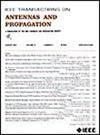基于SSPPs和周期模式调制方法的稳定连续双频漏波辐射
IF 5.8
1区 计算机科学
Q1 ENGINEERING, ELECTRICAL & ELECTRONIC
引用次数: 0
摘要
目前,双频漏波天线(DB-LWAs)要实现稳定、连续的前后波束扫描辐射仍然是一个挑战。在这篇通讯中,我们证明了欺骗表面等离子激元(SSPPs)和周期模式调制方法可以用来解决这个问题。提出了一种基于SSPPs传输线(TL)的双频调制漏波天线(LWA),由改进的基片集成同轴线和微带线组成。SSPPs的强色散效应使得LWA不仅可以满足低频段的−1次谐波辐射,而且可以实现高频段的−2次谐波辐射。由于每个调制周期的两个不连续点自然形成一对相互抵消的反射波,因此所提出的LWA可以同时抑制两个波段的开阻带(OSB)效应,并具有罕见的双频连续波束扫描能力。此外,sspp的慢波效应抵消了辐射能量随LWA频率的逐渐增加,导致泄漏波辐射更加稳定。实验结果表明,所提出的DB-LWA可在7-12.8 GHz和14-16.1 GHz两个频段分别实现−81°~ 42°和−44°~ 5°连续波束扫描,增益稳定性分别为0.13和0.19。本文章由计算机程序翻译,如有差异,请以英文原文为准。
Stable and Continuous Dual-Band Leaky Wave Radiation Based on the SSPPs and Periodic Mode-Modulation Method
Currently, it is still challenging for dual-band leaky wave antennas (DB-LWAs) to achieve stable and continuous backward-to-forward beam scanning radiation. In this communication, we prove that spoof surface plasmon polaritons (SSPPs) and periodic mode-modulation methods can be used to solve this problem. The proposed dual-band mode-modulated leaky wave antenna (LWA) consists of modified substrate-integrated coaxial lines and microstrip lines based on the SSPPs transmission line (TL). The strong dispersion effect of SSPPs allows the LWA not only to satisfy the −1st harmonic radiation in the low band, but also to realize the −2nd harmonic radiation in the high band. Because two discontinuities of each mode-modulation period form a pair of reflected waves naturally that can cancel each other, the proposed LWA can suppress the open-stopband (OSB) effect in two bands simultaneously with the rare dual-band continuous beam-scanning capability. Besides, the slow wave effect of the SSPPs counteracts the gradual increase in radiated energy with the frequency of the LWA, resulting in more stable leaky wave radiation. Experiment results confirm that the proposed DB-LWA can realize −81° to 42° and −44° to 5° continuous beam scanning in two bands (7–12.8 and 14–16.1 GHz), respectively, with the gain stability of 0.13 and 0.19, respectively.
求助全文
通过发布文献求助,成功后即可免费获取论文全文。
去求助
来源期刊
CiteScore
10.40
自引率
28.10%
发文量
968
审稿时长
4.7 months
期刊介绍:
IEEE Transactions on Antennas and Propagation includes theoretical and experimental advances in antennas, including design and development, and in the propagation of electromagnetic waves, including scattering, diffraction, and interaction with continuous media; and applications pertaining to antennas and propagation, such as remote sensing, applied optics, and millimeter and submillimeter wave techniques

 求助内容:
求助内容: 应助结果提醒方式:
应助结果提醒方式:


